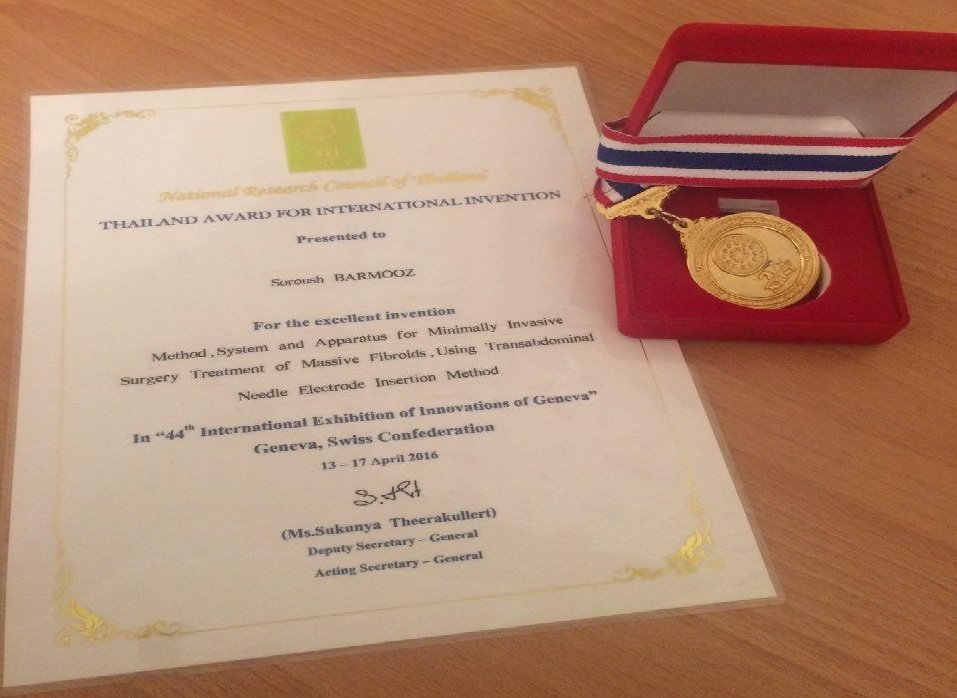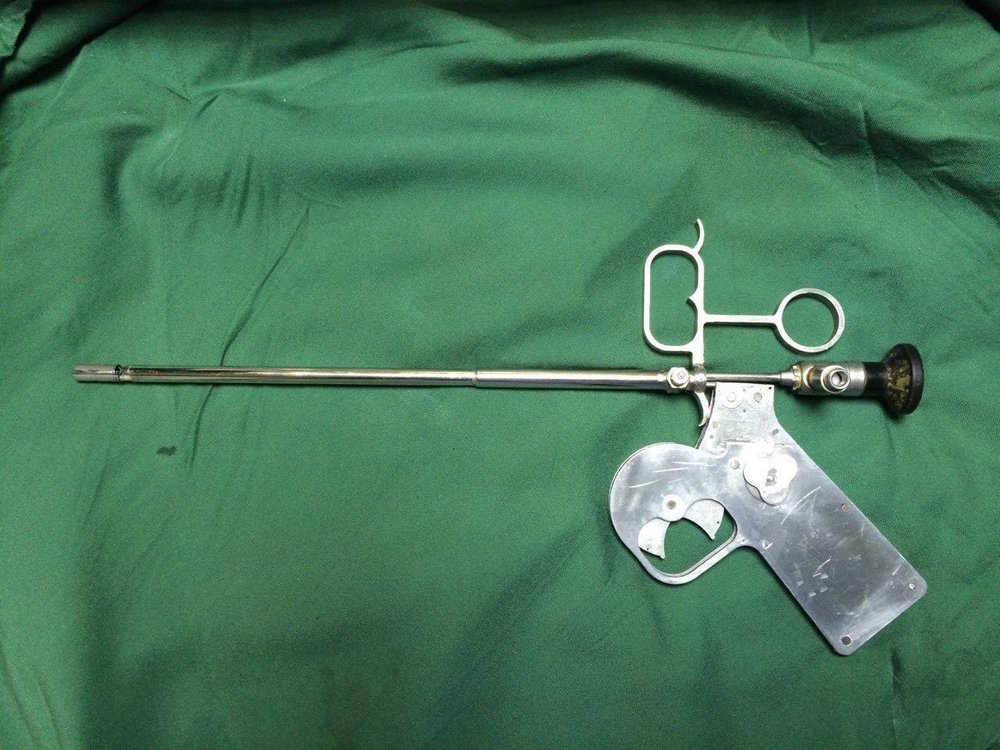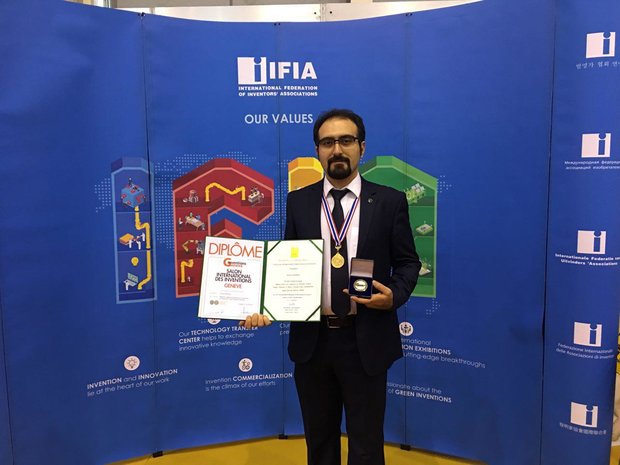Man has always been obsessed with coming up with new ideas to make life easier. Not all inventions have been practical or appreciated in their own times but they have certainly changed the way we live now one way or another. Ranging from fire and wheel to the most complicated space stuff, almost all inventions play important roles in our everyday lives. However, by the advancement of science the inventions have become more convoluted and in order to devise a practical instrument one usually needs some certain and relevant level of expertise and a team who would be able to help with different aspects of the project.
Soroush Barmooz, a young inventor who holds a masters degree in Biomedical Engineering from Amirkabir University of Technology (Tehran Polytechnic), has designed hysteroscopic surgical instrument to treat different types of benign uterine tumors, fibroids in women with a minimally invasive technique.
Barmooz, 28 from Mahabad, a city in the northwestern province of West Azarbaijan, believes his invention could help treat those benign uterine tumors with least side-effects possible, avoiding possible complications which may occur during or after the invasive procedures and help the patients live a normal life afterwards without worrying for adverse and undesirable effects a major surgery might cause. Aside from the surgical improvements Barmoozs invention would bring about, it can help eliminate the social and psychological problems which may arise from the disease, namely infertility and hysterectomy. In an exclusive interview to the Tehran Times, Barmooz has explained his path through his groundbreaking invention.
Please explain your invention.
We have developed four surgical instruments for treating uterine fibroids by minimally invasive myolysis (dissolution or liquefaction of muscular tissue) techniques. The idea of developing such instruments stems from my MSc thesis which I defended in February 2014. As a part of the thesis was to design a surgical hysteroscopic instrument for treating submucosal uterine fibroid (fibroids develop just under the lining of the uterine cavity). Mustafa Rostami, lecturer in Amirkabir University of Technology and Farah Farzaneh, of Shahid Beheshti University of Medical Sciences helped me through the project as well. [Hysteroscopy is a procedure that allows the doctor to look inside the uterus in order to diagnose and treat causes of abnormal bleeding.] The instrument is ergonomically compatible to the female reproductive system and the surgeons hands comprising multiple mechanisms each playing a special role to satisfy the requirements of the hysteroscopic operation.
The main mechanisms are a set of surgical electrodes which are anchored inside the fibroid for coagulation. Electricity is applied to the needles and delivered to the fibroid tissue and a subsequent necrosis (death of the cells) will occur. The applied radio frequency (RF) electricity causes a tissue heating up, which leads to a perfect necrosis and subsequently death of the tumor, and eventually leads to a shrinkage in the size of the fibroid. Based on the reports in literature, it might be up to 90 per cent after 6 months.
The necrosis also eliminates chances of tumor relapse in the future. The instrument does not affect the surrounding myometrium and the overlaying endometrium thanks to the specially designed stem insulated electrodes; contrary to old methods, it causes no damages to the uterus and any future pregnancy would be totally harmless. All the instruments are registered in the Iran Intellectual Property Office and United States Patent and Trademark Office (USPTO).

Have the instruments proved to be effective so far?
The myolysis technique is an approved method which has been under research from late 1980s up to now. Specialists are still developing the method in many universities in the world. The method has been approved by many scientists by running numerous clinical tests. The invention comprises special tools for easing and accelerating myolysis procedure. Currently, myolisis is treated by laparotomy and endoscopic techniques. However, there are some reports indicating that performing that technique by trans-cervically and trans-endometrially methods but as far as I have investigated, these methods are not popular yet, but definitely they will become the best fitting alternative for both the laparoscopic and the laparotomy methods.
Are there any similar invention in other parts of the world?
There are some reports indicating the use of trans-cervical and trans-endometrial methods; but as far as I know, those methods are not popular yet; nor are there any similar instruments in the market. In the best scenario, we are competing against the most up-to-date researches and anybody who gets to the finish line first will become the winner! We hope to be able to raise adequate fund as soon as possible before it becomes too late. The instruments are unique because there are not any similar ones abroad or in Iran.
You have registered your inventions at United States Patent and Trademark Office. How can this be helpful?
We applied for the patents in the United States for many reasons. First, the prevalence of fibroids is 70 per cent among the black women, while its prevalence is about 30 per cent in white women. Annually, 200,000 hysterectomies are performed mainly due to fibroids in the US. Its a shame that such a huge number of hysterectomies are operated in a country with population of more than 300 million, so the US will be the foremost country needing our surgical instruments as the best alternative for hysterectomies. Second, the US patent office is a leading organization in protecting intellectual properties and all credible patent offices worldwide conduct overall searches in their database and refer to the US patent office issued patents. So applying for a patent in the US patent office will guarantee your rights to the invention almost internationally.
A real problem regarding Irans Intellectual Properties Office is that their documents and databases are published and issued in Persian which rules out the possibility that foreign countries could conduct patent searches in Irans patent database; this would allow infringement of Iranians right to their inventions on international scale. It is not too late for other Iranian inventors to apply for patent in the US even if they had formerly applied for the Iranian patent.
Have you managed to attract any sponsor so far?
We have started looking for a sponsor since November and currently we are negotiating with some sponsors, banks and government organizations to finance our research and commercialize our instruments. We hope for raising sufficient fund soon before the Patent Office in the US registers an overriding invention. We believe that women deserve this to restore their health and preserving their uterine.
How hard is it to apply for a patent in Iran?
Fortunately applying for a patent in Iran is a straightforward and coherent process. The process is accurate and almost fast. But the main challenge is the commercialization which is hurdled in administrative and bureaucratic maze. The project needs long-term scientific and financial aid. Investors often seek quick-impact projects. Instead of investing on a project which might come to fruition in years, they can invest on a quick-impact project or importing and exporting goods and gain much more profit easily and in a shorter amount of time without taking the risks of investing on a project which may or may not pay off. In general, start-ups is a good idea for commercialization, but if you conduct a search you will see the most successful start-ups are almost internet-based services rather than complicated or scientific projects such as ours.
There are some organization in the government such as Presidents office which offers financial support to inventors with marketing ideas. But there are still some shortcomings and setbacks regarding the process. Unnecessary bureaucracy to enter the system is pretty time-consuming. They refer the inventors to the banks to appeal for fund but the banks are either facing budget deficit or they might ask for some assets to pledge as collateral for the loan. Government may recognize the importance of the projects, but the banking system might dismiss the fact that how time is crucial for such projects. China plays an important role in the worlds production. They manufacture almost everything and offer them in cheap and competitive prices. This has led to influx of industries from the US and Europe to China, thus rising unemployment figures in the U.S as well as the European countries. Merchants and manufactures prefer purchasing the most affordable product rather than manufacturing domestic products at a higher costs. Obviously, they would balk at the idea of investing in new and radical ideas.

In general, how supporting inventions could help a country make progress?
The answer to this question has many aspects. The most apparent impact an invention or an entrepreneurial venture can exert upon a country is the economic boom. Entrepreneurs can create jobs for the people and fuel economic growth. Inventions can also promote social welfare. Countries are divided into main categories as developed and developing or underdeveloped. In the underdeveloped societies, even if they need advanced technologies, there is no place for innovation, because they have to go through a lot of hardship to obtain their primary needs for surviving such as clean water and health. When all of the primary requirements are satisfied, they will turn to their secondary needs which relates to lifestyle and luxuary. Developed country usually encourage and foster innovations. There is a direct relation between introducing advanced technologies and the cutting-edge scientific discoveries and higher reasonable expectations in developed countries. Naturally, someone who has experienced air travel cannot use the old and traditional transportation system. It is natural that they will tend for using even more advanced systems such as ultrasonic airplanes and more.
What happens if you do not succeed in raising fund?
We have invented five surgical devices which need to be developed, tested, verified and certified by Ministry of Health. Completion of each phase might take about two years. We have showcased the inventions in many international exhibition; we reached out international companies and research centers to cooperate with us on the project. In the meantime there might be some people who adapt our idea without our confirmation or permission and start to develop it by adding or removing some features to or from our invention and make a totally different instrument which even we might fail to detect. The competition is fierce and we must be swift to take chances and leap at every opportunity to succeed. We named our group Mechatronism (like a mechanism which includes electronic devices.) We are absolutely determined and working hard day and night to get to reasonable result. We welcome any Iranian or foreign investors, and research centers to cooperate with us or invest on our invention to develop hysteroscopic and minimally invasive myolysis systems.











